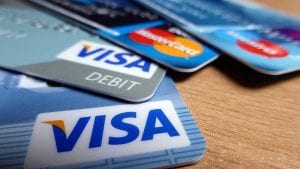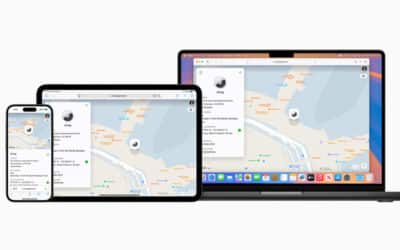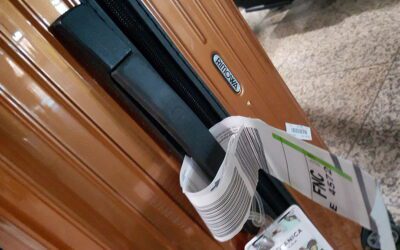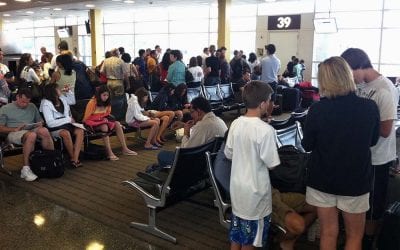Here are 20 tips to help you prevent identity theft and maintain security while traveling.

In the U.S., Americans have experienced a large increase in identity theft and fraud in 2024. Total losses from it hit $47 billion last year. According to a U.S. News and World Report survey in 2023, 16% of travelers surveyed said they experienced identity fraud while away from home.
Maintain security while traveling. Start before you leave on your trip. Pay your bills, call your bank and credit card companies, and clean out your wallet.
Deal with your bills before you leave:
Pay all your bills due during your trip before you leave. That way you won’t need to put your financial institution credentials at risk by logging in to pay bills on unsecured networks while away.
Call your bank and credit card companies about your trip:
While I’m slightly concerned that my bank and credit card companies would decline a transaction while I’m away, I’m more concerned that they would approve a fraudulent charge in my hometown during travels.
Clean out your wallet:
Most of us have every credit and debit card we own, IDs, membership cards, bank account numbers, etc., in our wallet. Before you leave on your trip, clean out your wallet of every unnecessary card, ID, etc., to minimize what could be lost or stolen while traveling.
If you can’t afford to lose it or don’t need it on your journey, leave it at home:
Don’t take anything with you on your trip that you can’t afford to lose. If it’s valuable, like expensive jewelry, and you don’t need it, leave it at home.
Passcode/Password your electronic devices:
Your electronic devices store a massive amount of personal information. If they are lost or stolen, this information is available to anyone who finds them. To protect your data, put in the longest passcode permitted on your smartphone and tablet, plus use a biometric password on your laptop, at a minimum.
Password protect your electronic devices, don’t use the same password, use two-step verification, avoid unsecured networks, and use a VPN connection when on the Internet while traveling.
Use different password protections for your accounts and make them strong and long:
Many people, including travelers, use the same password repeatedly. Once stolen, the same password can be used to unlock many accounts. Make your passwords long and strong. According to How Secure is My Password, an eight-digit strong password will hold up to hackers for about nine hours, but a 12-digit strong password will hold up for about 34,000 years.
Use a password manager:
It’s tough to remember strong, long passwords when you have a different password for every account. Password managers can rescue you by maintaining all your passwords and entering your login information automatically, defeating keystroke loggers.
Change your logins to two-step verification:
If you’re not familiar with it, two-step verification is a feature that requires you to enter a code, typically sent to your cellphone. In addition to your username and password, you log into an online account and add the code. The code is different each time you log in, so even if a hacker steals your password, they still can’t get in unless they steal the device to which your code is sent or somehow intercept its transmission, which is very hard to do.
Avoid unsecured or public WiFi networks if possible:
I never use unsecured or public WiFi networks at cafés, libraries, airports, parks, and malls. Hackers lurk in those networks to steal your identity and personal information.
Protect your online devices:
Make all Internet connections through a VPN connection/service. I use a VPN service for connections on my smartphone, tablet, and laptop whenever I travel. VPN connections are encrypted from your computer through the network you’re on all the way to the site to which you’re connected. Use anti-malware and anti-virus software on all devices.
Use ATMs at secured sites only and protect your PIN number.
Use ATMs only at secured sites:
While they are relatively rare, more and more ATMs have been hacked with electronic skimmers to steal your ATM card information. Stay away from ATMs in unsecured locations such as malls, shopping areas, airports, etc. I use ATMs solely at banks, as they have 24/7 security and surveillance video.
Keep your PIN numbers secure:
Never state a PIN publicly. When entering a PIN at an ATM or payment terminal, cover your hand while typing in the PIN.
Don’t put travel plans on line before you leave or travel experiences, videos, and photos while away on social media:
Don’t broadcast trip data on social media to tell thieves that your home will be or is empty. Post your comments, videos, and photos after you return home.
Carry one credit card when touring your destinations. Keep your travel documents, credit cards, and IDs secreted on your body with a neck pouch, money belt, or other device.

Pickpockets are looking for easy marks from travelers who think they need to carry all their IDs, debit, and credit cards whenever they go out. Don’t carry more than one credit card at a time, except while in transit between destinations. Carry one credit card and leave any other credit cards in your hotel room safe. Unless you’re going out to use an ATM, leave your debit card in the room safe, too.
A neck pouch, money belt, etc. to carry IDs, cards, and cash helps.
I always keep my credit cards and identification secret when traveling, using a neck pouch. I keep a small amount of cash in a Ridge-type wallet in my front pocket, where it’s safer than in a rear pocket.
Use a holster, crossbody strap, or tether for your cellphone.
Never put your cellphone in your pants pocket while traveling, particularly your back pocket, where it will likely stick out. I use a holster for mine. Many others secure theirs with a tether or crossbody strap.
A mobile wallet adds security.
Set up a mobile wallet on your cellphone. Use it instead of a credit card when possible.
I use ApplePay whenever possible worldwide to pay my bills rather than using my credit card directly. Mobile wallets are much safer than using credit or debit cards directly.
Beware public computers. Never log into sensitive websites on them.
Don’t use computers that are publicly available, such as those in hotels, to log into banks, etc. They aren’t safe. Instead, when necessary, use your cellphone to connect to those sites.
Extra credit/debit cards and receipts should be secured. Tablets and laptops should also be kept safe in your room whenever you are on the go or touring.
Keep receipts and travel papers safe in your hotel:
Receipts and travel papers have sensitive identity information on them. Keep them in your hotel room safe, not in your luggage or on your person when out and about.
Valuables should stay in your hotel room safe when not in use:
Place any valuables in your room safe. Add your tablet and laptop whenever you’re not using them.
Check credit card statements and bank accounts regularly:
While traveling, regularly check your credit/debit card and bank accounts. Ensure they haven’t been compromised. I’ve arranged to have my credit card companies text all account transaction details to my cellphone when they are made. I immediately know if a fraudulent transaction occurred.
It’s possible that you will still experience identity theft and have security problems while on the go. But following these commonsense tips will substantially reduce the odds that you’ll suffer from those serious problems.

READ ALSO:
Here come airlines’ baggage fees increases again
Yes, for an important event you SHOULD fly in a day early
After many years working in corporate America as a chemical engineer, executive and eventually CFO of a multinational manufacturer, Ned founded a tech consulting company and later restarted NSL Photography, his photography business. Before entering the corporate world, Ned worked as a Public Health Engineer for the Philadelphia Department of Public Health. As a well known corporate, travel and wildlife photographer, Ned travels the world writing about travel and photography, as well as running photography workshops, seminars and photowalks. Visit Ned’s Photography Blog and Galleries.



